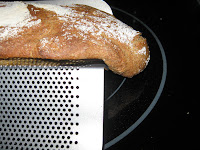Anyway, the Flax Council's Nutrition page has a useful table of weights to volumes. The Council also notes that whole flaxseed passes through you undigested, so it should be ground to release its nutritional benefits. The Council notes that "[a]bout 42% of flax seed is oil, and more than 70% of that oil is polyunsaturated fat, a healthy fat. Flax also contains 57% of the important omega-3 fatty acid, ALA." In addition, the Council notes that "Flax seed contains soluble and insoluble fibre" (we won't go into all the benefits the Council lists for that) and that "Flax seed is also one of the richest plant sources of lignans, providing up to 800 times more lignans than most other foods in a vegetarian diet." So what are lignans? The Council tells us that, too: "Lignans are phytoestrogens – compounds that have been shown in laboratory studies of animals to help protect against certain kinds of cancer, particularly cancers of the breast and colon, by blocking tumour formation." Seems to me, based on what we learned baking the Quinoa Bread that if you only eat quinoa and flaxseed you might live forever--or at least it might seem that way.
The Council notes that whole flaxseed will keep for a year kept dry at room temperature. Once ground, however, it must be refrigerated and will only keep for 30 days. The Council suggests grinding it as you need it. You can use a coffee grinder or blender or food processor. That is where the conversion table comes in handy, since you can weigh the amount you need and not grind too much. For our purposes, 1 cup of ground seed weighs 130 grams, and a tablespoon 8 grams. I made both loaves at the same time, and weighted out the amount I needed, plus just a little extra figuring there would be a bit of a loss in the grinder.
Since I made them at the same time it was interesting to see how the two different doughs rose. The 100% whole wheat did not rise nearly as much as the Roasted Garlic, which has a fair amount of AP flour (slightly more than 50%) and is thus much lighter. The same held true with the baked loaves.
I baked the 100% Whole Wheat and Flaxseed first. I made a boule, and baked it in my flame orange cast iron Le Creuset pot.
(We watched Julie and Julia again over the holidays, for inspiration, and noted that Julia had a Le Creuset dutch oven of the same color.)
As already noted, the loaf was dense. No doubt the oil in the flaxseed contributed to the denseness, compounding the whole wheat flour's tendency toward denseness. Also, one of the other bloggers noted that she increases the amount of vital gluten when using freshly ground flour. I did add a bit extra, but perhaps more would have helped, though at some point you would need to adjust the water as well.

 Notwithstanding the denseness of the loaf, we enjoyed it very much. The flaxseed contributed a nice nuttiness to the whole wheat, and this was particularly noticeable when it was toasted. As this sojourn has progressed I have gotten more and more fond of whole grain breads. And, as the old adage goes, "the whiter your bread the sooner you're dead." Now, living on quinoa, flaxseed AND whole wheat bread seems a bit more doable, especially if a jug of wine and my groupie (a "thou") are included in the mix.
Notwithstanding the denseness of the loaf, we enjoyed it very much. The flaxseed contributed a nice nuttiness to the whole wheat, and this was particularly noticeable when it was toasted. As this sojourn has progressed I have gotten more and more fond of whole grain breads. And, as the old adage goes, "the whiter your bread the sooner you're dead." Now, living on quinoa, flaxseed AND whole wheat bread seems a bit more doable, especially if a jug of wine and my groupie (a "thou") are included in the mix. I baked the Roasted Garlic Loaf for New Year's Eve dinner. In addition to the roasted garlic, AP flour, and flaxseed this bread uses spelt flour, which I also ground fresh. Spelt is basically an heirloom wheat. Wikipedia notes that it is "[a] hardy wheat grown mostly in Europe for livestock feed."
 My friend Chris, who bakes the most spectacular cakes on the North Coast (she has a cake business and if you are interested check her out at Martines of Ohio)
My friend Chris, who bakes the most spectacular cakes on the North Coast (she has a cake business and if you are interested check her out at Martines of Ohio) 
gave me a perforated French Bread pan for Christmas, so I tried it out on this loaf.


I used the entire half batch, since the pan looked like it needed more than a quarter batch, and let it rise in the pan, which I sprayed with canola spray even though it is non-stick (belt and suspenders). But that turned out to be a bit too much dough--the dough kept trying to escape. I corralled it before putting it in the oven, but it make a break for it again as it baked.
Still, the loaf baked up beautifully, with a terrific crust (in part due to the relative dearth of whole wheat flour, which gives a softer crust due to the natural oils).
Because the dough was wet, it oozed a bit through the holes in the pan as it rose, which made it stick a bit, but I used a flexible spatula and it popped right out.


In addition to the nice crust this loaf has a really good crumb. Those features coupled with the roasted garlic gave us a loaf we all liked very much.
Hope all have a safe, healthy, happy and propserous new year.









Great post. I have the same bread pan and have had the dough ooze through the holes also, but the bread has always seems to come out. I haven't been with braid for a while, but with the New Year I am going to try harder. :)
ReplyDeleteAs usual, I really enjoyed this post. I love all the informational tidbits you add- its fun to learn new things. The roasted garlic bread looks great.
ReplyDeleteElwood and Mama,
ReplyDeleteHave missed your posts. Hope you are back for the new year.
Love your posts, havent been game to look at the schedule after all the overeating I have done during the holiday period.
ReplyDeleteLOVE, LOVE your posts! Thanks so much for the trivia. Thanks for posting the weights on the flax, saving me work of looking it up.
ReplyDeleteI have the same experience with the same type of loaf pan. Also, if I try to make 2 loaves, they ooze together at the top. If one of us figures out how to make it work, I think we should post that.
I have the same Perforated French Bread Pan and I use it almost every week. I love the way it bakes bread although I've not had any problems with the dough oozing through the holes. You do have to spray it with oil or it will stick a bit. I usually make 1/2 recipe and then make 2 baguettes which works out well for the size of the pan.
ReplyDeleteThanks for all the info on Flaxseed, I had no idea! I guess it's a good thing I like both Quinoa and Flaxseed!
Your breads both look super! I've found that just using Unbleached Flour does not have the taste that I like any more. So I have started adding just a little WW flour to most of the recipes. And just this week I started using 10-Grain Flour which is wonderful.
Glad you're still with me!
Michelle
Thanks for a fun year of baking and writing. I like your historical and nutritional additions. I like the flaxseed, too, and am daily reminded of it's value because we give our son flaxseed oil twice a day, I believe to ward off inflammation.
ReplyDeleteYour breads look good. It's fun to have new equipment to try out, especially when it's a gift!